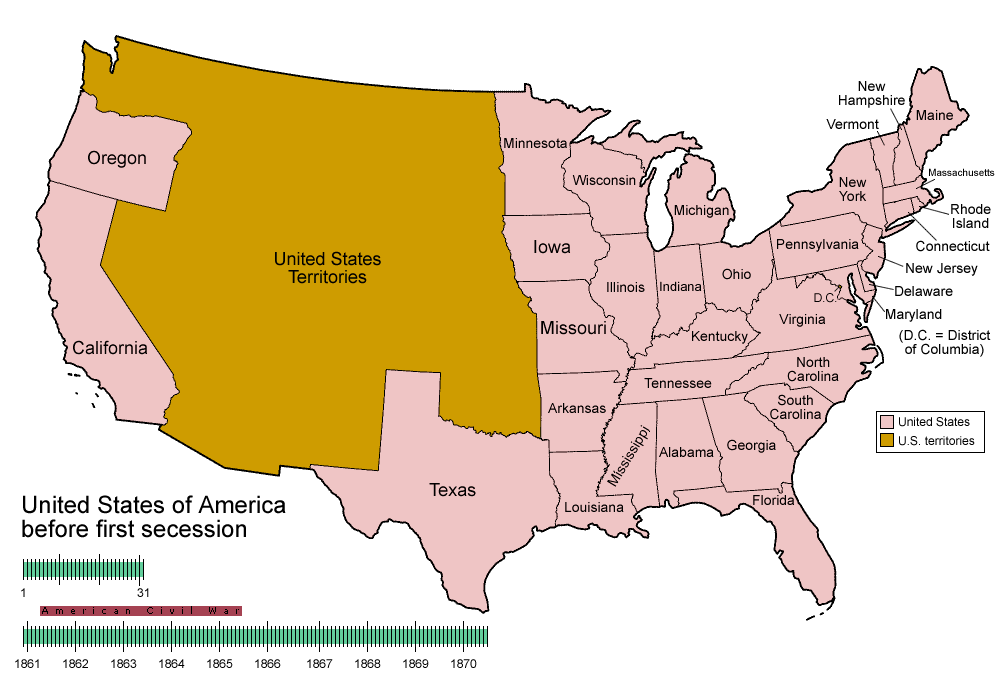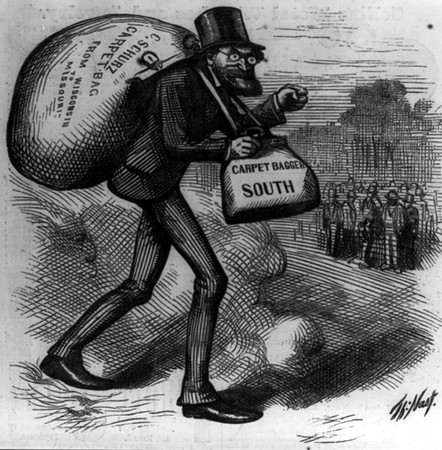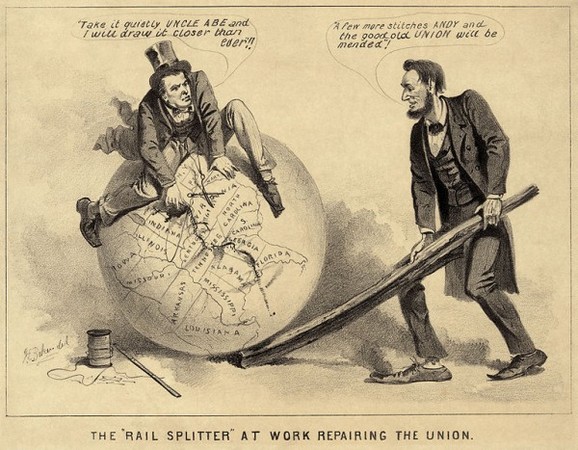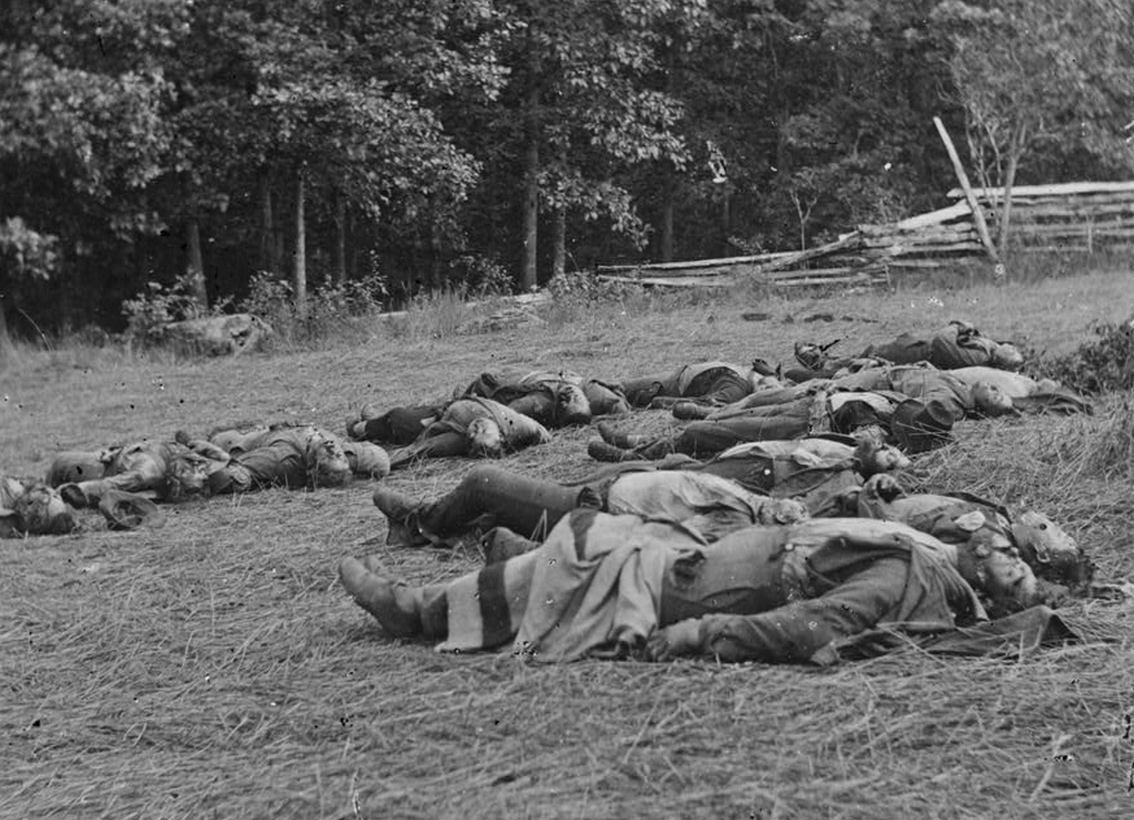|
Reconstruction
Reconstruction Timeline
| Reconstruction Timeline Map with Event Dates |

|
| Reconstruction Timeline Map for Readmission of Southern States into the Union. |
December 1863: President Abraham Lincoln announces
his reconstruction plan. It offers general amnesty to all white Southerners who take an oath of future loyalty and accept
wartime measures abolishing slavery. Whenever 10% of the number of 1860 voters take the loyalty oath in any state, those loyal
citizens can then establish a state government. In early 1864, the governments of Louisiana, Arkansas, and Tennessee are reconstructed
under Lincoln’s "Ten Percent Plan." Radical Republicans are shocked at the policy’s leniency, so Congress refuses
to recognize the governments or seat their elected federal representatives.
July 1864:
Congress passes its own reconstruction plan, the Wade-Davis bill. It requires a majority of 1860 voters to take a loyalty
oath, but only those who swear an "ironclad" oath of never having fought against the Union can participate in reconstructing
their state’s government. Congress requires the state constitutions to include bans on slavery, disfranchisement of
Confederate political and military leaders, and repudiation of Confederate state debts. After Congress adjourns, Lincoln refuses
to sign the Wade-Davis bill, so it is "pocket-vetoed" and not implemented.
March 1865:
Congress creates the Bureau of Refugees, Freedmen, and Abandoned Lands, commonly known as the Freedmen’s Bureau, within
the War Department. It provides temporary relief to the freedpeople in the form of basic shelter and medical care, assistance
in labor-contract negotiation, the establishment of schools, and similar services. At its peak, though, the Freedmen’s
Bureau only has 900 agents in the South.
April 1865: The Civil War ends with Confederate
General Robert E. Lee’s surrender to Union General Ulysses S. Grant at Appomattox, Virginia.
President Lincoln is
assassinated. Vice President Andrew Johnson, a Southern Democrat, assumes
the presidency.
| Reconstruction Timeline of Events |

|
| The Loathsome Carpetbagger, 1872 |
| Reconstruction Timeline History |

|
| Southern perception of Union Reconstruction of the South |
(Left) "The Rail Splitter Repairing the Union" — a political
cartoon of Vice President Andrew Johnson, who was the only US senator from the South who refused to resign during the
Civil War, and President Abraham Lincoln during Reconstruction in 1865. Cartoon shows Andrew Johnson, then considered
a traitor by most Southerners, sitting atop a globe, dictating Reconstruction terms to Lincoln while attempting to stitch
together the map of the United States with needle and thread. Lincoln responds by saying that "A few more stitches Andy and
the good old Union will be mended." (Right) The carpetbagger was an unscrupulous opportunist from the Northern states
who went to the South after the Civil War to profit from Reconstruction. Similar to the carpetbagger, the scalawag was
a white Southerner -- usually a local -- who collaborated with Northern Republicans (often called
Radical Republicans) during Reconstruction for personal gain. The term was also used derisively by white Southern
Democrats who opposed Reconstruction legislation. Although Gen. Sherman coined the phrase that war is all hell, the carpetbagger
and scalawag had to continually look over his shoulders because most Southerners were now eager with an opportunity
to assist in filling the hot place.
| Ruins, Rubble, and Reconstruction in Richmond |

|
| Because of Civil War, the Confederate capital of Richmond lay in ruins and rubble. April 1865. |
(About) As a result of Civil War, the large Southern city was generally
a target, including Richmond, which was hemorrhaging from high casualties and a decimated infrastructure. Rural
areas in the South were known for agriculture, but absent manpower, including slaves, farms eroded
and became large lots overrun with brush, weeds, and small trees. Most men from the local community often enlisted in
the same company or regiment, and when the unit was in battle, a single volley fired from an artillery piece often
spelled disaster for entire families and communities alike. After the war, with little if any available manpower, widows and
orphans often cleared and tended a meager parcel in an attempt to grow and harvest their necessary
sustenance. While a poor yield or an illness in the family generally defined disaster, Reconstruction and
Civil Rights Acts were rarely given much thought. Surviving the four year war was a partial victory, but to battle
Reconstruction and Civil Rights Acts, and carpetbaggers and scalawags, that was for folks that already had enough
to sustain that was necessary to for
removed the and then raked with canister from an artillery battery, it of When the war concluded,
several communities had lost nearly all their men due to military service.
lots, were neglected, overgrown, inhabited by deserters, raided by guerrillas, -- with most of the men wearing
Confederate gray -- local men who were on the battlefield, and subjected to the average farms overgrown because they
lacked manpower during the Civil War as well as
Summer 1865: President Johnson implements his reconstruction plan. It offers general amnesty
to those taking an oath of future loyalty, although high-ranking Confederate officials and wealthy Confederates have to petition
the president for individual pardons. The plan also requires states to ratify the 13th Amendment which prohibits slavery and
to repudiate Confederate debts.
December 1865: Congress refuses to recognize the
state governments reconstructed under Johnson’s plan. Republicans are disturbed by the reluctance of white Southerners
to ratify the 13th Amendment, their refusal to grant voting rights to black men, their enactment of black codes which limit
the rights and liberties of blacks, and their election of former Confederates, such as Confederate Vice President Alexander
Stephens, to state and national offices.
February 1866: Congress passes the Freedmen’s
Bureau Act, which extends the temporary agency’s life indefinitely and gives the military the responsibility of protecting
the civil rights of black Americans in the former Confederate states. President Johnson vetoes the bill, surprising many Republicans.
April 1866: Congress enacts the Civil Rights Act of 1866. It grants citizenship to all persons born or naturalized in
the United States, and guarantees them equal rights under the law. The statute makes it a federal crime, punishable by fine
and imprisonment, to deprive any person of his or her civil rights. Judicial authority over the act is assigned to the federal
courts. President Johnson vetoes the bill, but Congress overrides the veto and the bill becomes law.
May
1866: A race riot erupts in Memphis.
June 1866: Congress approves a proposed 14th
Amendment to the U.S. Constitution. Its text begins with the first definition of citizenship in the Constitution: all persons
born or naturalized in the United States. It thereby attempts to give the citizenship clause of the Civil Rights Act of 1866
more legitimacy and permanency by incorporating it into the Constitution. The amendment also denies states the authority to
deprive citizens of their privileges and immunities, the due process of law, or the equal protection of the law.
July 1866: Congress passes the Freedmen’s Bureau Act a second time. President Johnson vetoes it again, but this
time Congress overrides his veto.
Congress votes to readmit representatives from Tennessee after that state’s ratification
of the 14th Amendment. A race riot occurs in New Orleans.
August - September 1866: President Johnson, joined by key administration figures, embarks on a speaking tour called
the "swing around the circle." The president is trying to build support for the election that fall of politicians sympathetic
to his policies. He imprudently, if sarcastically, suggests the execution of leading Radical Republicans and sincerely blames
Congress for the New Orleans riot (they blame him). Rumors fly of Johnson’s alleged drunkenness. The tour is a public
relations fiasco, undermining popular and Congressional support for the president.
Fall 1866:
The Congressional elections are seen as a national referendum on the proposed 14th Amendment. Republicans score a major victory,
gaining seats to give them over a two-thirds margin in the next Congress—more than enough to override any presidential
vetoes.
March 1867: Congress passes the first Reconstruction Act. The former Confederacy
is divided into five military districts under the direction of military officers, who are supported by federal troops. Military
courts can be used to try cases involving civil and property rights violations, as well as criminal trials. States have to
enact new constitutions that grant voting rights to black men. High-ranking Confederate officials are temporarily barred from
political participation. States must ratify the 14th Amendment in order to be represented in Congress. President Johnson vetoes
the bill, but Congress overrides the veto. The Southern states, though, refuse to carry out the law.
Congress passes the
second Reconstruction Act. It gives the military district commanders directions on holding state constitutional conventions.
The president vetoes the bill and Congress overrides his action. The president is forced to implement Congressional reconstruction,
but the Johnson administration interprets it as narrowly as possible.
| Reconstruction was accompanied with great loss |

|
| Dead Soldiers on Gettysburg Battlefield, July 1, 1863 |
July 1867: Congress enacts the third Reconstruction Act. It affirms the authority of the military
district commanders to remove state officials from office.
Fall 1867: The remaining
ten unreconstructed states vote to hold constitutional conventions and thus begin the process of reconstruction under the
Congressional military plan. At this time there are 15,000 troops in the South—only 1 soldier per 725 inhabitants. By
1870, the number is down to 6,600, falling further to 3,000 by 1876.
March 1868: Congress
passes the fourth Reconstruction Act. It allows the proposed state constitutions to be ratified by a simple-majority vote
in each state.
The House of Representatives impeaches President Andrew Johnson: Johnson had angered Republicans by his
interference with and intransigence on various recontruction policies and the Tenure of Office Act.
May 1868: The Senate votes to acquit Johnson. He remains in office, but is denied renomination by the Democratic party.
June 1868: Congress readmits representatives from seven states: Alabama, Arkansas, Florida, Georgia, Louisiana, North
Carolina, and South Carolina.
July 1868: The 14th Amendment is ratified by the
requisite number of states and becomes a part of the U.S. Constitution. It is one of the most consequential additions to the
Constitution in American history.
November 1868: Republican Ulysses S. Grant,
hero of the Civil War, is elected president over his Democratic rival, Horatio Seymour, the former governor of New York.
1869 - 70: "Redeemer" governments begin to be elected across the South. The majority of white Southern voters replace
the biracial Republican state governments, created under Congressional reconstruction, with white-only Democratic state governments,
which are sympathetic to the former Confederate cause and opposed to racial equality. In 1869, Tennessee establishes a "redeemer"
government, with Georgia, North Carolina, and Virginia following suit in 1870.
February 1869:
Congress passes the proposed 15th Amendment to the U.S. Constitution. It attempts to shore up the constitutional protection
of black voting rights by stipulating that voting rights cannot be denied on the basis of "race, color, or previous condition
of servitude." It also gives Congress the enforcement authority through appropriate legislation.
April 1869: The U.S. Supreme Court announces its decision in Texas v. White, upholding the constitutionality of Congressional
Reconstruction. In a 5-3 decision, Chief Justice Salmon Chase declares that the Union is "composed of indestructible states,"
thus making secession illegal; that although Texas had never left the Union, it no longer has a legitimate state government;
and Congress has the authority to restore a republican government to the state.
Early 1870:
Congress votes to admit representatives from the remaining three unreconstructed states: Mississippi, Texas, and Virginia.
March 1870: The 15th Amendment is adopted by the requisite number of states and becomes part of the U.S. Constitution.
May 1870: Congress enacts the first Enforcement Act to enforce the 14th and 15th Amendments. The law makes the bribing,
intimidation, or racial discrimination of voters into federal crimes. The statute also strengthens federal authority against
anti-black groups like the Ku Klux Klan by outlawing conspiracies aimed at preventing the exercise of constitutional rights.
February 1871: Congress passes the second Enforcement Act authorizing federal supervision of Congressional elections
in cities with populations exceeding 20,000. The South was largely unaffected by this law, however, since there were few cities
of that size in the region.
April 1871: In response to President Grant’s request
for more federal authority to combat anti-black violence in the South, Congress enacts the Ku Klux Klan Act. It grants the
federal government the authority to punish the denial of equal protection or privileges and immunities. In addition, the statute
bestows on the president the power to suspend habeas corpus and to use the military against anti-civil rights conspiracies.
October
1871: President Grant, acting under the authority of the Ku Klux Klan Act, imposes martial law and suspends the
writ of habeas corpus in South Carolina.
November 1872: President Grant wins reelection
against his Democratic/Liberal Republican opponent, New York Tribune editor Horace Greeley.
1873: A redeemer government is elected in Texas.
Fall 1874: Democrats win control
of both houses of Congress for the first time since before the Civil War. Redeemer governments win control in Arkansas and
Alabama.
March 1875: The outgoing Republican Congress enacts the Civil Rights Act
of 1875, long advocated by Senator Charles Sumner, who died shortly before its passage. It outlaws racial segregation in all
public accommodations regulated by law, such as hotels, theaters, steamships, and railroads. The U.S. Supreme Court will rule
the law unconstitutional in 1883.
1875: A redeemer government is elected in Mississippi.
Nov. 1876 - Feb. 1877: Samuel Tilden, the Democratic presidential nominee, wins a narrow majority of the popular
vote against Rutherford Hayes, the Republican nominee. The electoral votes in three states—South Carolina, Florida,
and Louisiana—are disputed. They are the only Southern states left with federal troops stationed there under Reconstruction
policy. A bipartisan electoral commission is appointed by Congress to settle the controversy. On a party-line vote, it gives
all the disputed electoral votes to Hayes, making him president. After his inauguration, President Hayes removes the final
federal troops from the three states.
1877: After his inauguration, President Hayes removes the remaining federal troops in South Carolina,
Florida, and Louisiana from political duty (guarding the statehouses). Redeemer governments assume power in South Carolina,
Florida, and Louisiana.
Following a bitterly disputed presidential contest between Republican
Rutherford B. Hayes and Democrat Samuel Tilden, in which both candidates claim victory, Hayes is declared president. In a
back-room political deal, the Republicans agree to abandon Reconstruction policies in exchange for the presidency. Reconstruction
policies officially end. And, although the South had been defeated in Civil
War, it claimed that it had won the "War for Reconstruction."
Recommended Reading: Reconstruction:
America's Unfinished Revolution, 1863-1877.
Review: This "masterful treatment of one of the most
complex periods of American history" (New Republic)
made history when it was originally published in 1988. It redefined how Reconstruction was viewed by historians and people
everywhere in its chronicling of how Americans -- black and white -- responded to the unprecedented changes unleashed by the
war and the end of slavery. This "smart book of enormous strengths" (Boston Globe) has since gone on to become the classic
work on the wrenching post-Civil War period -- an era whose legacy reverberates still today in the United States. Continued below...
About
the Author: Eric Foner, DeWitt Clinton Professor
of American History at Columbia University, is the author of numerous
works on American history, including Free Soil, Free Labor, Free Men: The Ideology of the Republican Party Before the Civil
War; Tom Paine and Revolutionary America; and The Story of American Freedom. He has served as president of both the Organization
of American Historians and the American Historical Association, and has been named Scholar of the Year by the New York Council
for the Humanities.
Recommended
Reading: A Short History of Reconstruction.
Review: In an attempt to document the important issues
of reconstruction, Eric Foner compiled his book Reconstruction: America's
Unfinished Revolution, 1863-1877. Foner addresses all the major issues leading up reconstruction, and then finishing his book
shortly after the end of reconstruction and the election of Rutherford B. Hayes in 1876.
In the preface of his book, Foner discusses the historiography of Reconstruction. He notes that during the early part
of the twentieth century many historians considered Reconstruction as one of the darkest periods of American history. Foner
notes that this viewpoint changed during the 1960s as revisionists shed new "light" on reconstruction. The revisionists saw
Andrew Johnson as a stubborn racist, and viewed the Radical Republicans as "idealistic reformers genuinely committed to black
rights." The author notes that recent studies of reconstruction argue that the Radicals were actually quite conservative,
and most Radicals held on to their racist views and put up very little fight as the whites once again began to govern the
south. Continued below...
Foner initially
describes the African-American experience during the Civil War and Reconstruction. He argues that African-Americans were not
simply figures that took little or no action in the events of the day, and notes the enlistment of thousands of African-Americans
in the Union army during the war. Foner also notes that many of the African-Americans that eventually became civil leaders
had at one time served in the Union Army. He states, "For men of talent and ambition, the army flung open a door to advancement
and respectability." He notes that as reconstruction progressed, African-Americans were the targets of violence and racism. Foner
believes that the transition of slaves into free laborers and equal citizens was the most drastic example of change following
the end of the war. He notes how African-Americans were eventually forced to return to the plantations, not as slaves but
as share croppers, and were thus introduced to a new form of slavery. He argues that this arrangement introduced a new class
structure to the South, and states "It was an economic transformation that would culminate, long after the end of Reconstruction,
in the consolidation of a rural proletariat composed of a new owning class of planters and merchants, itself subordinate to
Northern financiers and industrialists.” The author illustrates how both blacks and whites struggled to use the state
and local governments to develop their own interests and establish their respective place in the evolving social orders. Another
theme that he addresses in this excellent study is racism itself and the interconnection of race and class in the South.
Another subject
he addresses is the expanded presence of federal authority, as well as a growing idea and commitment to the idea that equal
rights belonged to all citizens, regardless of race. Foner shows how both Northern and Southern blacks embraced the power
to vote, and, as Reconstruction ended, many blacks saw the loss of suffrage and the loss of freedom. Foner illustrates that
because the presence of blacks at the poll threatened the established traditions, corruption increased, which helped to undermine
the support for Reconstruction. The former leaders of the Confederacy were barred from political office, who were the regions
"natural leaders," a reversal of sympathies took place which portrayed the Southern whites as victims, and blacks unfit to
exercise suffrage.
Reconstruction
affected the North as well, but argues that it was obviously less revolutionary than it was in the South. Foner notes that
a new group of elites surfaced after the war, industrialists and railroad entrepreneurs emerged as powerful and influential
leaders alongside the former commercial elite. The Republicans in the North did attempt to improve the lives of Northern blacks.
However, there were far fewer blacks in the North, so it was more difficult for blacks to have their agendas and needs addressed
in the local legislatures. He states, "Most Northern blacks remained trapped in inferior housing and menial and unskilled
jobs." Foner adds that the few jobs blacks were able to acquire were constantly being challenged by the huge influx of European
immigrants.
Foner's subject
is definitely worthy of his original volume. Reconstruction is a subject that can still be interpreted in several ways, including
the revisionist school of thought. Foner, however, seems to be as objective as possible on this subject, and has fairly addressed
all major issues that apply.
Recommended
Viewing: American Experience - Reconstruction: The Second Civil War (DVD) (175 minutes). Description: Spanning the years from 1863
to 1877, this dramatic mini-series recounts the tumultuous post-Civil War years. America was grappling with rebuilding itself, with bringing the South
back into the Union, and with how best to offer citizenship to former slaves. Stories of
key political players in Washington are interwoven with
those of ordinary people caught up in the turbulent social and political struggles of Reconstruction.
Recommended
Reading: Forever Free: The Story of Emancipation and Reconstruction. Description: In Forever Free, Eric Foner,
the leading historian of America's Reconstruction
Era, reexamines one of the most misunderstood periods of American history: the struggle to overthrow slavery and establish
freedom for African Americans in the years before, during, and after the Civil War. Forever Free is extensively illustrated,
with visual essays by scholar Joshua Brown discussing the images of the period alongside Foner's text. (From Publishers Weekly:
Starred Review.) Probably no period in American history is as controversial, as distorted by myth and as "essentially unknown"
as the era of emancipation and Reconstruction, award-winning historian Foner (The Story of American Freedom; Reconstruction;
etc.) argues in this dense, rectifying but highly readable account. His analysis of "that turbulent era, its successes and
failures, and its long-term consequences up until this very day" addresses the debates among historians, corrects the misrepresentations
and separates myth from fact with persuasive data. Continued below…
Foner opens
his work with an overview of slavery and the Civil War and concludes with a consideration of the Civil Rights movement and
the continuing impact of Reconstruction upon the current political scene, a framework that adds to the clarity of his history
of that era, its aftermath and its legacy. Joshua Brown's six interspersed "visual essays," with his fresh commentary on images
from slavery through Reconstruction to Jim Crow, buttress Foner's text and contribute to its accessibility. In his mission
to illuminate Reconstruction's critical repercussions for contemporary American culture, Foner balances his passion for racial
equality and social justice with disciplined scholarship. His book is a valuable, fluid introduction to a complex period.
|

